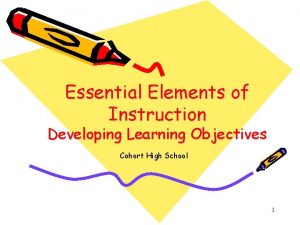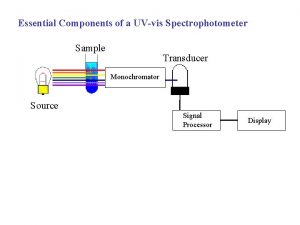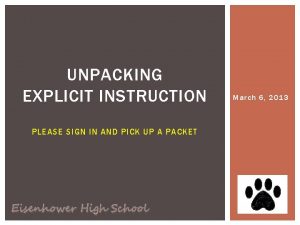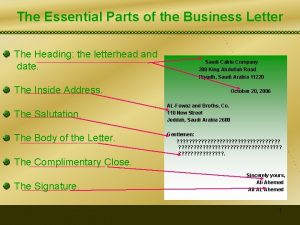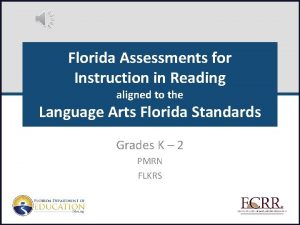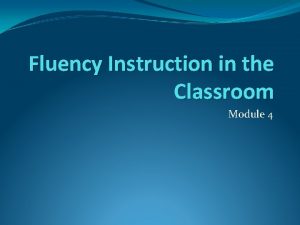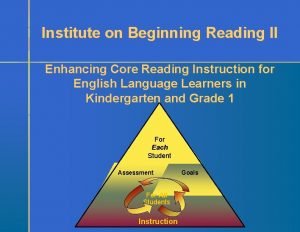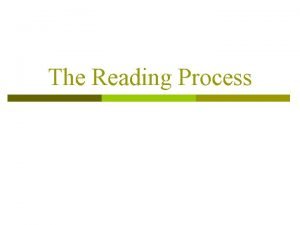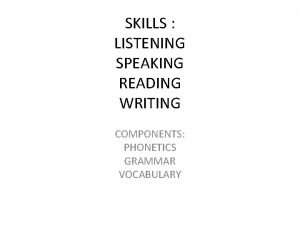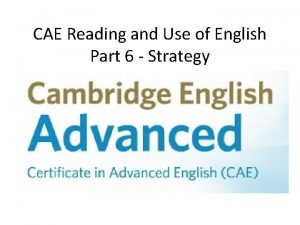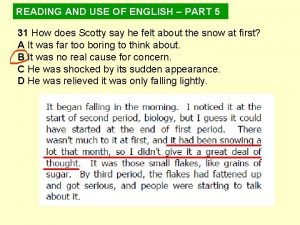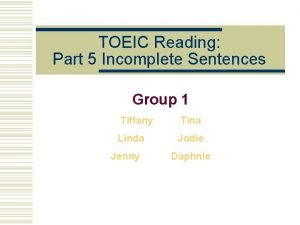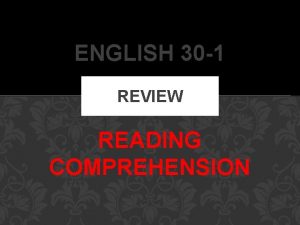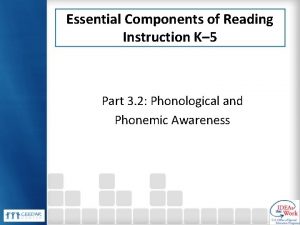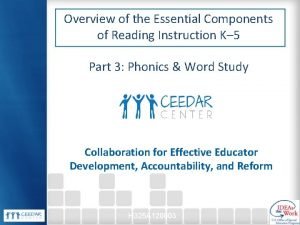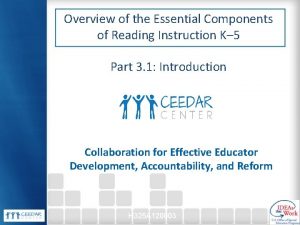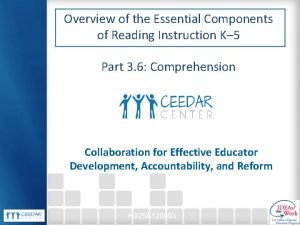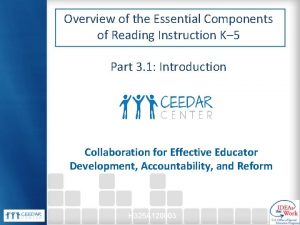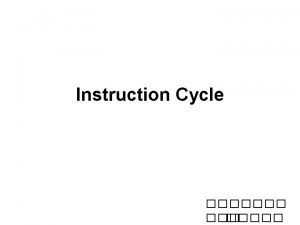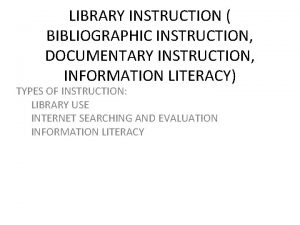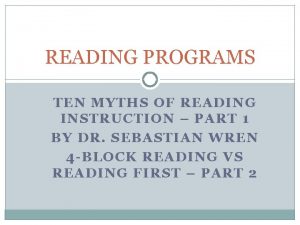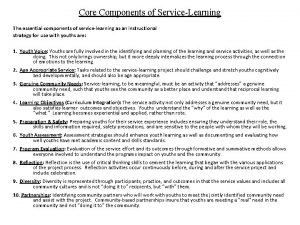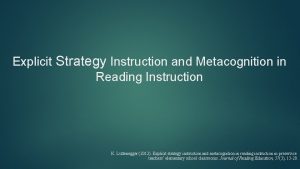Essential Components of Reading Instruction K 5 Part



































- Slides: 35

Essential Components of Reading Instruction K– 5 Part 3. 4: Fluency Collaboration for Effective Educator Development, Accountability, and Reform H 325 A 120003

Module Outcomes 1. Design instruction for all students 2. Differentiate instruction 3. Use assessment data to inform instruction; form groups; and monitor progress 4. Incorporate standards and evidence-based practices (EBPs)

Acknowledgments Much of the information in this fluency presentation has been adapted from: • Texas Fourth Grade Teacher Reading Academy, Vaughn Gross Center for Reading and Language Arts at the University of Texas at Austin, ©University of Texas System/TEA And from the work of: • Jan Hasbrouck, Ph. D. , Educational Consultant


Common Core Standards Read with sufficient accuracy and fluency to support comprehension. a. Read on-level text with purpose and understanding. b. Read on-level text orally with accuracy, appropriate rate, and expression on successive readings. c. Use context to confirm or self-correct word recognition and understanding, rereading as necessary. http: //www. corestandards. org/

Fluency Terms • Automaticity is the quick, effortless, and accurate reading of words. • Prosody is reading expressively, pausing for punctuation and phrasing appropriately. Hasbrouck & Hougen, 2012

Fluency Involves. . . • Reading with automaticity, accuracy, and prosody. • Phonological, orthographic, and morphological knowledge of letters, letter patterns, and words. • Effective and efficient processing of this information in connected text. Hasbrouck & Hougen, 2012; O’Connor, 2014

Fluency • Should be taught from the beginning of the reading-acquisition process • Has implications for assessment, intervention, and prevention of reading difficulty. Hasbrouck, 2010; National Reading Panel Report, 2000; National Research Council, 1998; Wolf et al. , 2000;

Ultimate Goal • Comprehension of text • Motivation to read

Causes of Comprehension Difficulties Lack of. . . • Background knowledge • Language foundation • Metacognitive skills • Ability to organize content and context • Decoding skills • Fluency Pikulski & Chard, 2005

Fluent Readers. . . • Focus attention on comprehension • Do NOT focus on decoding • Read effortlessly • Enjoy reading


Kindergarten Skills • Letter naming • Letter-sound correspondence • Phrase reading • Rereading of decodable and predictable text Honig et al. , 2008

First Grade • Letter-sound correspondence • Word recognition • Phrase reading • Rereading of decodable, predictable text • 50 -60 WPM by EOY Honig et al. , 2008; O’Connor, 2014

Second Grade • Word recognition • Phrase reading • Reading of grade-level book. • 90 -100 WCPM by EOY Honig et al. , 2008

Third Grade • Read grade-level text aloud with appropriate rate, accuracy, and prosody • More than 110 WPM by EOY Honig et al. , 2008

Hasbrouck & Tindal, 2006

WCPM Gains Per Week by Grade Fuchs et al. , 1993 Grade Words per Week 1 2 to 3 2 1. 5 to 2 3 1 to 1. 5 4 . 85 to 1. 1 5 . 5 to. 8 6 . 3 to. 65

50 Percentile ORF EOY Norms Grade WCPM at 50 %tile 1 53 2 89 3 107 4 123 5 139 6 150 Hasbrouck & Tindal, 2006

NAEP Measures of Prosody Levels 4: Reads with expressive interpretation. 3: Reads in three- to four-word phrase groups. 2: Reads in two-word phrases, awkwardly grouped 1: Reads primarily word by word. National Center for Education Statistics, NAEP-Oral Reading Fluency, 2002 http: //nces. ed. gov/nationsreportcard/studies/ors/scale. asp

Fluency Assessment Students read aloud for 1 minute Count number of words read Subtract words read incorrectly Difference is words read correct per minute (WCPM) • Assess percent accuracy (in needed) • Check with oral reading fluency norms (ORF) • •

Procedures • Encourage best reading, not fastest • Do NOT say “Ready, set go!” • DO say, calmly, “You may begin now. ”

Comprehension Probes • Ask one to two comprehension questions. OR • Ask the student to retell the story or summarize the passage.

Fluency Instruction • Teacher models • Repeated reading • Partner reading • Choral reading O’Connor, 2014

Repeated Reading • Fosters fluent word recognition • Encourages rapid decoding • Increases confidence • Enhances comprehension Hasbrouck & Hougen, 2012; O’Connor, 2014

Repeated Reading Procedures • Student reads short passage aloud. • When student makes an error, hesitates, or asks for help, teacher says the word. • Student repeats the word and rereads the sentence. • Student reread the text three times.

Partner Reading: Benefits • • • Provides repeated reading benefits Increases fluency Increases time reading Maximizes student engagement Provides a model of fluent reading Creates opportunities for individual support O’Connor, 2014; Vaughn & Linan-Thompson, 2012

Partner Reading Procedures 1. Reader 1 reads passage aloud 2. Reader 2 listens and corrects 3. Readers change roles; Reader 2 reads same text as Reader 1 4. Repeat allowing each partner to read the same text two times

Partner Reading Scripts • Stop. Read that word again. • Yes, that word is. . . • Reread the sentence. OR • No, that word is. . . • What word? • Reread the sentence.

Sample Retell • Reader 2 asks questions about sequence of events in passage. • Reader 1 retells the passage by answering the questions.



Other Fluency-Building Activities • Choral reading • Echo reading • Computer-based and tape-assisted reading • Chunking or rereading portions of text • Performance reading Hasbrouck & Hougen, 2012; O’Connor, 2014

Research indicates… • Repeated reading is the “gold standard” • Combine strategies for best results and to motivate students – Modeling – Repeated reading – Progress monitoring Hasbrouck, 2010

Helpful Sites • www. fcrr. org • www. meadowscenter. org • http: //reading. uoregon. edu • http: //iris. peabody. vanderbilt. edu/
 While reading activities
While reading activities Plamatic acid
Plamatic acid Essential elements of instruction
Essential elements of instruction Individualized instruction vs differentiated instruction
Individualized instruction vs differentiated instruction Difference between direct and indirect instruction
Difference between direct and indirect instruction Components of spectrophotometer
Components of spectrophotometer Components of explicit instruction
Components of explicit instruction Formsl letter
Formsl letter Florida assessments for instruction in reading
Florida assessments for instruction in reading Fluency oriented reading instruction
Fluency oriented reading instruction Enhanced core reading instruction
Enhanced core reading instruction Dawn reithaug
Dawn reithaug Scarborough's rope poster
Scarborough's rope poster Listening speaking reading writing are the components in
Listening speaking reading writing are the components in Elar mc meaning
Elar mc meaning Part part whole addition
Part part whole addition Part to part ratio definition
Part to part ratio definition Brainpop ratios
Brainpop ratios Part by part technical description example
Part by part technical description example Part of a bar
Part of a bar The part of a shadow surrounding the darkest part
The part of a shadow surrounding the darkest part Two way anova minitab 17
Two way anova minitab 17 Reading part 6 pet
Reading part 6 pet Cae reading tips
Cae reading tips Scotty weems fce answers
Scotty weems fce answers Night reading quiz (part 1)
Night reading quiz (part 1) Toeic incomplete sentences
Toeic incomplete sentences English 30-1 reading comprehension practice test
English 30-1 reading comprehension practice test Round robin reading vs popcorn reading
Round robin reading vs popcorn reading Reading aims
Reading aims Kind of reading
Kind of reading Edb net
Edb net Process of discovery in critical reading
Process of discovery in critical reading Intensive reading and extensive reading
Intensive reading and extensive reading Intensive and extensive reading
Intensive and extensive reading Style of reading
Style of reading


